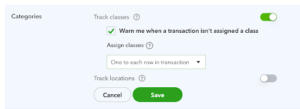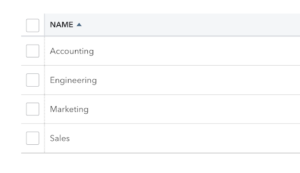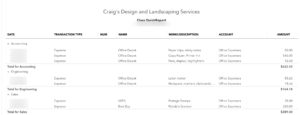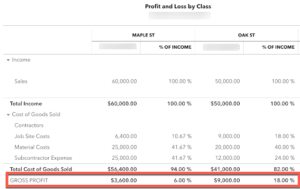Most business owners do not like reading financial reports. That is why they hire us! You know your financial statements will help you make better decisions, but they are so difficult to understand. Is there a way to see the parts of the business that matter the most to you? One way to solve this problem is by using classes in QuickBooks Online (QBO). Let’s discuss what classes are in QBO and when you might use them.
What are classes?
Classes usually represent parts of the business that are meaningful to you. When they are used, they can give you additional insight into sales, expenses, and profitability.
Classes are used on the transactional level, meaning that as transactions are recorded, they need to be assigned to a class. As transactions are assigned, you can run financial reports by class to look deeper into your accounting activity.
In what situations could classes be used? Let’s discuss three common scenarios.
You manage your business by department
If your business is organized by specific departments, classes are a great way to manage budgets and expenses.
For instance, let’s say you have spent approximately $4,000 on office supplies so far this year, but you want to know which departments have purchased these supplies.
The departments within your organization are as follows:
- Sales
- Marketing
- Accounting
- Engineering
If these departments all purchase office supplies from the same vendors, how can you track their expenses? We can use classes to organize these expenses.
First, let’s turn on classes in QBO. (Gear icon>Advanced>Categories)

Next, we want to create our classes in QBO for each department. (Gear Icon>Manage Lists>Classes)

Now that we have our classes, we want to assign the appropriate class to each office expense made this year. In the example below, this purchase should be assigned to the Marketing department.

Finally, we can run a Class Quick Report for office expenses to see the breakdown of expenses by each department.

If you manage budgets for your departments, QBO gives you the added ability to create budgets by class as well. You could create budget targets for each department, assign transactions as they occur to the appropriate department, and then run reports comparing actual expenses to the budget.
You do business in multiple regions
If you have sales or manage offices in multiple locations, classes can help you to see which regions are the most profitable.
Let’s say your company has sales in the North, South, East, and West areas of the state. You want to know which areas are bringing in the highest sales. In this instance, we can use classes in QBO to assign transactions by region.
As invoices, bills and expenses are recorded in QBO, we want to make sure we assign the transactions to a specific region. See an example of an invoice below:

Finally, let’s run a Profit and Loss by Class report. Since we assigned all the transactions to their respective regions, this report can now provide us with a breakdown of sales for the region.

What insights do we find from this report? If you determine that a specific region is generating more sales, you can redirect efforts to gain more clients in that area. Perhaps some techniques used in the West region can be duplicated to boost sales across the entire business.
QBO Expert Tip: You can also use Locations in QBO to track transactions by a specific region or area.
You use job costing for projects
If you work in the construction industry, most revenue is tracked by project. How can classes benefit you? Let’s look at another example.
Let’s say your company uses QBO and you are working on two separate residential home projects. You have a target goal to make a 15% gross profit margin on every project. You want to know how profitable each project is so you can ensure you are charging enough for your services. Again, classes in QBO can assist us with this.
QBO Expert Tip: Depending on your business, you may find Projects in QBO to be a better option. To learn more about Projects, check out this blog here.
After turning on class tracking, creating a class for each project, and assigning transactions for each class, let’s run a report to see how each project is doing. We can do this using the Profit and Loss by Class report.

As we can see, the Oak St. project so far is doing well. We have a healthy gross profit of 18%.
However, Maple St. is not doing well at all. It’s only generating 6%. How can this report help us?
Let’s focus on the Maple St. project. Based on the figures in this report, you can ask yourself some deeper questions:
- Have we properly invoiced all milestone payments or time/material expenses to our client?
- Is it possible that our original estimate for labor, subcontractors, or materials was too low compared to the actuals? If so, what was the reason?
- Is my gross profit margin for this type of project realistic?
- What changes can I make on future projects based on the outcome of this one?
We can see that by adding and assigning our accounting activity by class and reviewing the data, we can expand our view of the business and make adjustments to improve it.
Classes help you dig deeper
Classes are great tools to help you gain a deeper understanding of the activity of your business. You can peel back the layers of your business story with additional insights. Those insights can help you make more confident decisions.
However, a word of caution is needed: The success of using classes heavily depends on every transaction being assigned to a class. This feature should be used with a specific purpose in mind. We suggest having a conversation with your bookkeeper or accountant before using classes. They can offer the best recommendations on how to use them.
Even if you are able to track your sales and expenses by class, how do you know if the rest of your bookkeeping is right? Check out this article we wrote about how to verify your financial reports are accurate.

